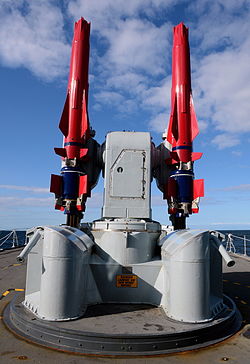
Back Sea Dart (ЗРК) Bulgarian Sea Dart Czech Sea Dart German Sea Dart Spanish Sea Dart Finnish Sea Dart (missile) French Sea Dart Italian シーダート (ミサイル) Japanese Sea Dart (зымыран) Kazakh Sea Dart (missil) NB
This article needs additional citations for verification. (July 2020) |
| Sea Dart | |
|---|---|
 Sea Dart drill missiles on HMS Edinburgh in 2012 | |
| Type | Surface-to-air, surface-to-surface |
| Place of origin | United Kingdom |
| Service history | |
| In service | 1973–2012 |
| Used by | See § Operators |
| Wars | Falklands War Gulf 1991 |
| Production history | |
| Designer | Hawker Siddeley Dynamics |
| Designed | 1963 |
| Manufacturer |
|
| Produced | 1970-2012 |
| No. built | 2,000+ |
| Specifications | |
| Mass | 550 kg (1,210 lb) |
| Length | 4.4 m (14 ft) |
| Diameter | 0.42 m (17 in) |
| Wingspan | 0.9 m (3.0 ft) |
| Warhead | 11 kg (24 lb) HE blast-fragmentation |
Detonation mechanism | Proximity fuze and contact |
| Engine | Chow solid-fuel booster motor Bristol Siddeley Odin ramjet cruise motor |
Operational range |
|
| Flight ceiling | 18,300 m (60,000 ft)[1][verification needed] |
| Maximum speed | Mach 3.0+[2][verification needed] |
Guidance system | Semi-active radar illuminated by radar Type 909 (J-band) |
Steering system | Control surfaces |
Launch platform | Ship |
Sea Dart, or GWS.30[a] was a Royal Navy surface-to-air missile system designed in the 1960s and entering service in 1973. It was fitted to the Type 42 destroyers (United Kingdom and Argentina), Type 82 destroyer and Invincible-class aircraft carriers of the Royal Navy. Originally developed by Hawker Siddeley, the missile was built by British Aerospace after 1977. It was withdrawn from service in 2012.
Britain's first naval surface-to-air missile was GWS1 Seaslug, which entered service in 1963. This used beam riding guidance which offered limited accuracy and was useful only against slower targets. The need for a higher performance system was seen even as it entered service.
Bristol Aerospace, which had recently introduced the ramjet-powered Bloodhound missile for the RAF, won the ensuing competition with another ramjet design. Compared to Seaslug, Sea Dart was faster, had much greater range, and its semi-active radar homing guidance was much more accurate and allowed attacks against supersonic targets.
The system had nine confirmed successful engagements in combat, including six aircraft, a helicopter and two anti-ship missiles. An additional helicopter was shot down in a 'friendly fire' incident during the Falklands War.
Cite error: There are <ref group=lower-alpha> tags or {{efn}} templates on this page, but the references will not show without a {{reflist|group=lower-alpha}} template or {{notelist}} template (see the help page).